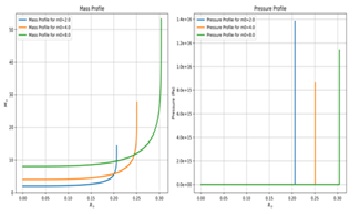Critical Mass Thresholds for Neutron Star Stability and Black Hole Formation in Gravitational Collapse
DOI:
https://doi.org/10.61343/jcm.v3i02.84Keywords:
Neutron star, Tolman-Oppenheimer-Volkoff equation, black hole, gravitational collapse, stellar stabilityAbstract
This research investigates the critical mass thresholds for black hole formation during the gravitational collapse of massive stars. Using numerical simulations and analytical techniques, we model the collapse of spherically symmetric, non-rotating neutron stars by solving the Tolman-Oppenheimer-Volkoff (TOV) equation. We first derive an analytical solution for the TOV equation under the assumption of constant density, estimating the maximum neutron star mass to be 2.85 solar masses. We then incorporate a customized density profile, as predicted in our previous work, into the TOV framework. This yields a critical mass of 2.096 solar masses at a radius of approximately 10 km, consistent with current theoretical and observational expectations. The maximum stable mass with this profile is calculated to be 2.36 solar masses, with the mass decreasing to zero beyond 15.5 km. By analyzing different initial masses (2.0, 4.0, and 8.0 solar masses) using a polytropic equation of state (EOS), we examine the mass-radius and pressure-radius relationships. Our results reveal a highly non-linear and abrupt change in mass and pressure distributions, indicating the formation of a dense outer shell. This structural feature could significantly influence neutron star stability and the conditions leading to black hole formation. These findings provide valuable insights into the maximum mass limits of neutron stars, aiding in the interpretation of astrophysical observations and the identification of potential black hole progenitors.
References
Oppenheimer, J. R. and Volkoff, G. M., 1939, Phys. Rev., 55, 507.
Carvalho, G.A., et al., 2015, J. Phys.: Conf. Ser., 630 012058.
Rhoades, C. E and Ruffini, R., 1974, Phys. Rev. Lett., 32, 324.
Nauenberg, M. and Chapline, G., 1973, Jr., Astrophys. J., 179, 417.
Hartle, J. B. 1978, Phys. Repts., 46, 201.
Friedman and Ipser, 1987 March 15, The Astrophysical Journal, 314:594-597.
Padmanabhan, T, 2017, Theoretical Astrophysics, Volume2, Cambridge University Press, p 271.
Srinivasan, G, 2002, The maximum mass of neutron stars, Bull. Astr. Soc. India 30, 523.
Abhayankar, K. D. 2016, Astrophysics: Stars and Galaxies, University Press, pp. 177-178.
Gangopadhyay, Bijan Kumar 2024, “Astronomy & Astrophysics with Relativity and Particle Physics”, Techno World, Kolkata, pp. 228-230.
Gangopadhyay, Bijan Kumar, 2018, “Limiting mass of a neutron star”, Proceedings of the DAE Symp. on Nucl. Phys. 63.
Pols, O. R., 2011 September, “Stellar Structure and Evolution”, Astronomical Institute Utrecht, p 28-29.
Fonseca, E., Cromartie, H. T., Pennucci, T. T., Ray, P. S., Kirichenko, A. Yu., et al. (2021), “Refined Mass and Geometric Measurements of the High-mass PSR J0740+6620”, The Astrophysical Journal Letters, 915(1), L12, https://doi.org/10.3847/2041-8213/ac03b8.
Rocha, Lívia S. et al, 2024, “Mass Distribution and Maximum Mass of Neutron Stars: Effects of Orbital Inclination Angle”, Universe, 10(1), 3.
Romani, R. W., et al. (2022). "PSR J0952-0607: The most massive neutron star observed, with a mass of approximately 2.35 M." Astrophysical Journal Letters, 934(2), L17.
Antoniadis, J., et al. (2013), "A Massive Pulsar in a Compact Relativistic Binary", Science, 340(6131), 448-450.
Özel, F., & Freire, P. (2016), "Masses, Radii, and the Equation of State of Neutron Stars", Annual Review of Astronomy and Astrophysics, 54, 401-440.

Downloads
Published
How to Cite
License
Copyright (c) 2025 Bijan Kumar Gangopadhyay

This work is licensed under a Creative Commons Attribution 4.0 International License.
Copyright© by the author(s). Published by journal of Condensed Matter. This is an open access article distributed under the terms of the Creative Commons Attribution (CC BY) license (https://creativecommons.org/licenses/by/4.0/), which permits unrestricted use, distribution, and reproduction in any medium, provided the original author(s) and source are credited.









